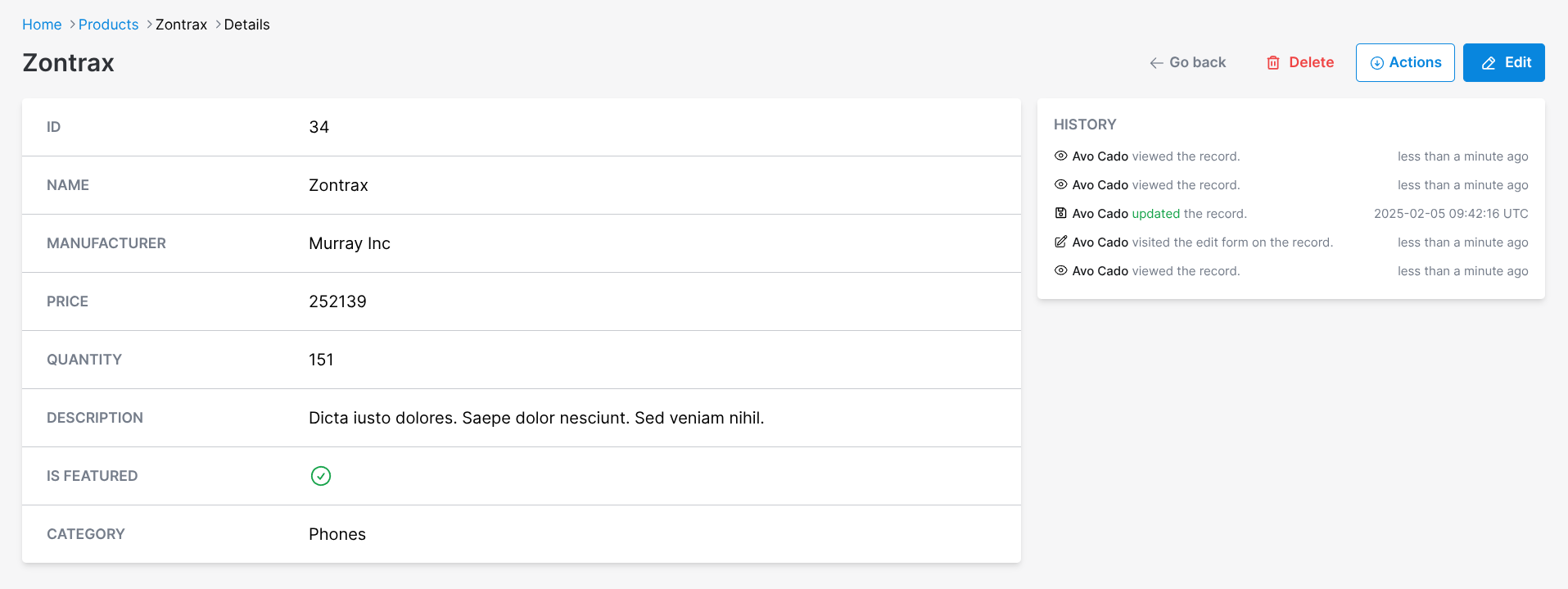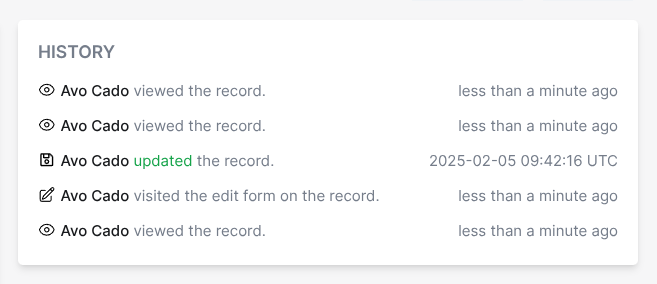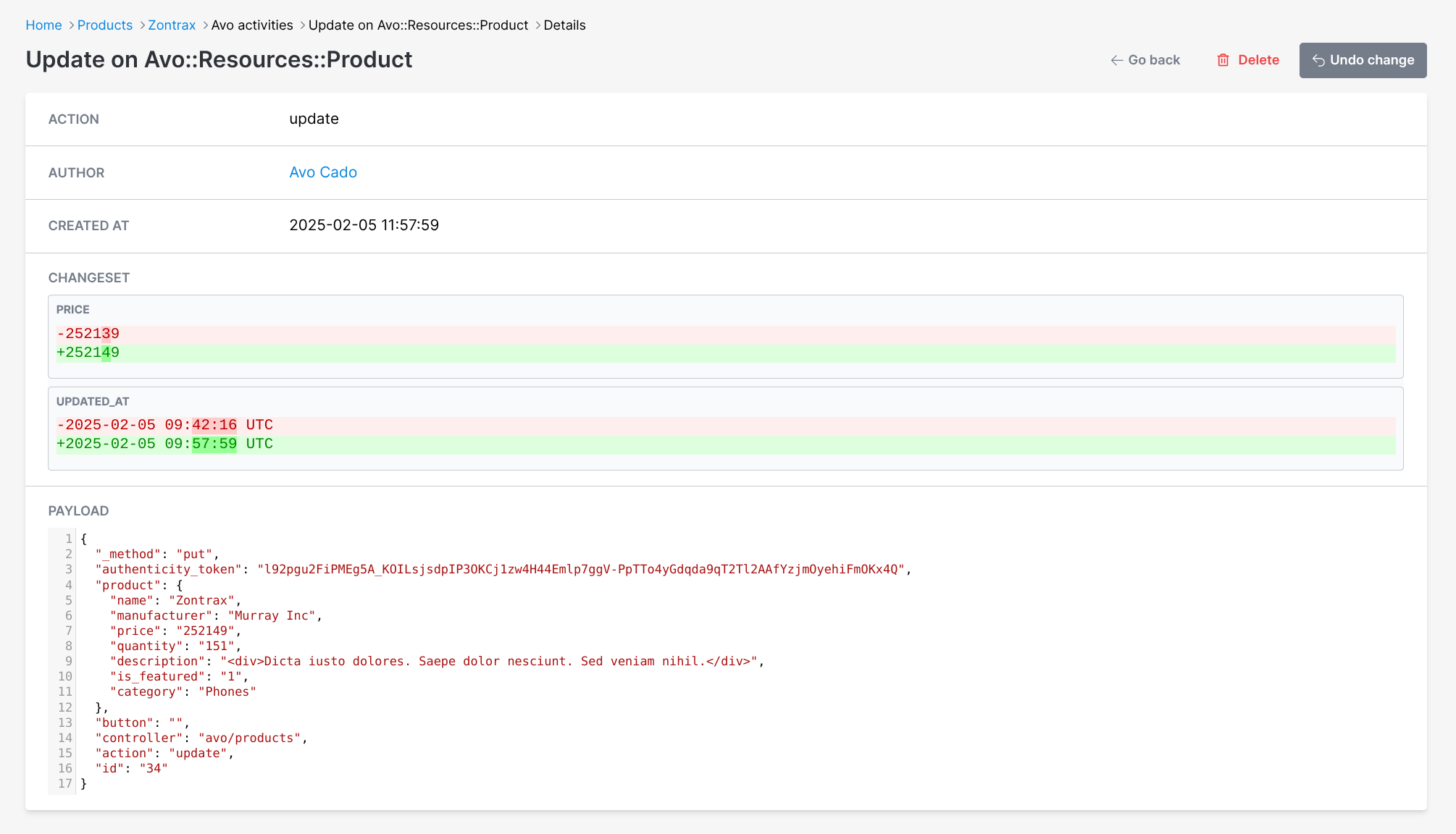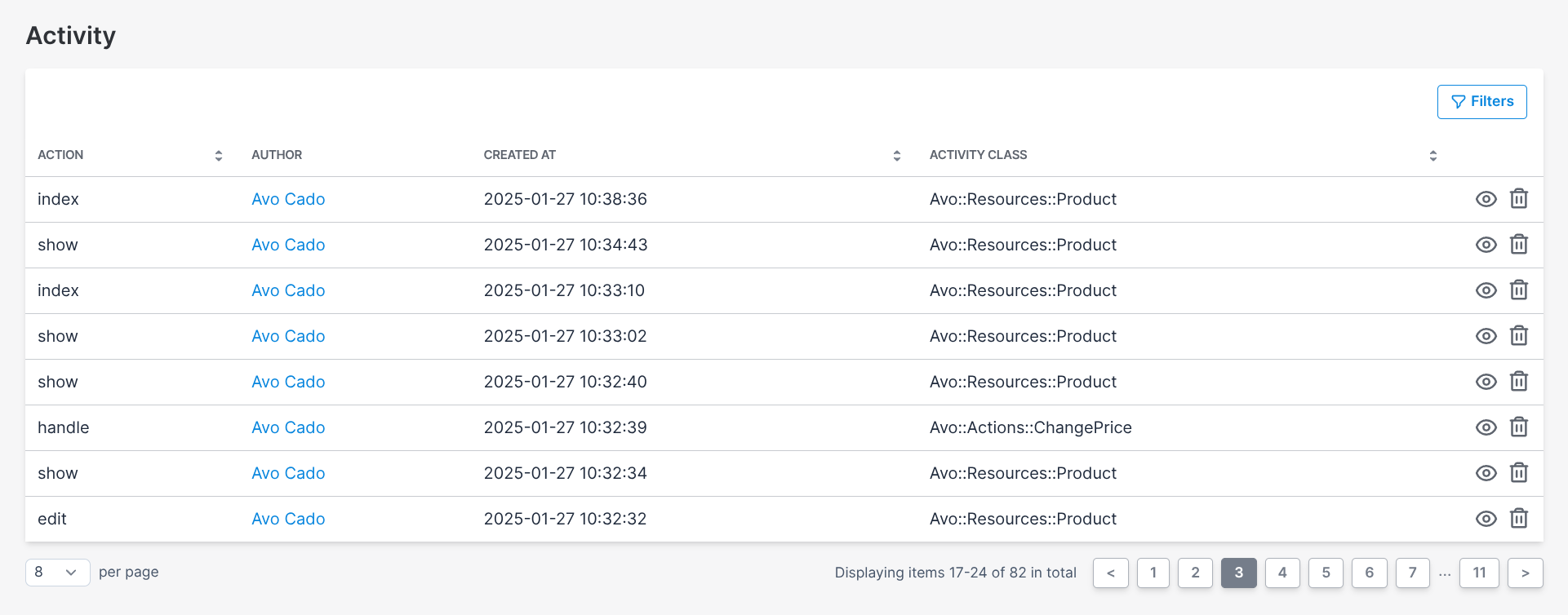Audit Logging
Avo's Audit Logging feature provides a seamless way to track and visualize user activity and changes within your applications. It seamlessly integrates with paper_trail, offering flexible installation and customization options.
Captures user activities on Avo resources and actions, recording details such as the author and the performed event.
The installation process will automatically generate the necessary migrations, resources, and controllers that power activity tracking. Additionally paper_trail will be installed if it is not already present in your project.
Requirements
avo-advanced
Installation
INFO
When installing avo-audit_logging on an application, we strongly recommend following this documentation page step-by-step without skipping sections, as it was designed with that approach in mind.
1. Install the gem
Start by adding the following to your Gemfile:
gem "avo-audit_logging", source: "https://packager.dev/avo-hq/"Then
bundle install2. Run the installer
bin/rails generate avo:audit_logging install3. Migrate
At this stage, all migrations, resources, and controllers required for the audit logging feature are set up and ready, it's time to migrate:
bin/rails db:migrateEnable and configure audit logging
Global enable
After installation, audit logging is disabled by default. To enable it, navigate to your avo.rb initializer file and update the configuration for the Avo::AuditLogging module.
Set config.enabled to true within this configuration.
# config/initializers/avo.rb
Avo.configure do |config|
# ...
end
Avo::AuditLogging.configure do |config|
# config.enabled = false
config.enabled = true
# config.author_model = "User"
endINFO
Setting this configuration to false will disable the audit logging feature entirely, overriding any other specific settings. We'll cover those specific settings in the next steps.
WARNING
Setting this configuration to false will not prevent previously registered activity from being displayed.
To control the display behavior when this configuration is set to false, you can wrap the relevant fields or tools within an Avo::AuditLogging.configuration.enabled? condition, like this:
class Avo::Resources::User < Avo::BaseResource
def fields
field :id, as: :id, link_to_record: true
field :email, as: :text, link_to_record: true
field :products, as: :has_many
if Avo::AuditLogging.configuration.enabled?
field :avo_authored, as: :has_many, name: "Activity"
end
end
endConfigure author models
INFO
If User is your only author model, you can skip this step as it will be automatically set by default.
Avo must determine the potential author models to correctly establish associations in the background. This setup enables the retrieval of all activities associated with a specific author via the avo_authored association. To designate a model as an author, use config.author_model, for multiple models, utilize config.author_models.
# config/initializers/avo.rb
Avo.configure do |config|
# ...
end
Avo::AuditLogging.configure do |config|
config.enabled = true
# config.author_model = "User"
config.author_model = "Account"
# Or for multiples models
config.author_models = ["User", "Account"]
endEnable specific resources and actions
At this stage, the audit logging feature should be enabled, but activities are not yet being saved. By default, only resources and actions that are explicitly enabled for auditing will be tracked.
To enable audit logging for specific resources or actions, use the self.audit_logging class attribute.
class Avo::Resources::Product < Avo::BaseResource
self.audit_logging = {
activity: true
}
def fields
field :id, as: :id, link_to_record: true
field :name, as: :text, link_to_record: true
field :price, as: :number, step: 1
# ...
end
def actions
action Avo::Actions::ChangePrice
end
endclass Avo::Actions::ChangePrice < Avo::BaseAction
self.name = "Change Price"
self.audit_logging = {
activity: true
}
def fields
field :price, as: :number, default: -> { resource.record.price rescue nil }
end
def handle(query:, fields:, current_user:, resource:, **args)
query.each do |record|
record.update!(price: fields[:price])
end
end
endAll resources and actions with audit logging activity enabled are being tracked now.
But these activities aren't visible yet, right? Let's look at how to display them in the next step.
Display logged activities
Resource-Specific Activities
The Avo::ResourceTools::Timeline tool, provided by the avo-audit_logging gem, is designed for use in the sidebar. It offers a compact view of activities that have occurred on a specific resource, presenting them in a streamlined format:

Configuring the Sidebar for Activity Tracking
To enable this feature, configure the resource to include the resource tool in the main menu sidebar:
class Avo::Resources::Product < Avo::BaseResource
self.audit_logging = {
activity: true
}
def fields
main_panel do
field :id, as: :id, link_to_record: true
field :name, as: :text, link_to_record: true
field :price, as: :number, step: 1
sidebar do
tool Avo::ResourceTools::Timeline
end
end
field :avo_activities, as: :has_many
end
def actions
action Avo::Actions::ChangePrice
end
endViewing and Navigating Activity Logs
Hovering over an entry reveals the precise timestamp in UTC. Clicking on an entry navigates to a detailed page displaying the full payload.

Enabling Change Logs and Reverting Changes
By default, update activities do not display a change log, and there is no way to revert changes. This is because PaperTrail has not yet been enabled on the model. To enable it, simply add has_paper_trail to the model:
# app/models/product.rb
class Product < ApplicationRecord
has_paper_trail
belongs_to :user, optional: true
validates_presence_of :price
endOnce enabled, the changelog will be visible, along with an action to revert changes.

Troubleshooting: Missing changeset Field
WARNING
If the changeset field in the versions table consistently appears as nil, ensure you add the following configuration in your application.rb file:
config.active_record.yaml_column_permitted_classes = [Symbol, Date, Time, ActiveSupport::TimeWithZone, ActiveSupport::TimeZone]Display author logged activities
We’ve already covered how to view all activity on a specific record. Now, let’s display a table within Avo::Resources::User to view all tracked activity for a particular user.

WARNING
If you're using a model other than User, make sure you have already configured the author models.
class Avo::Resources::User < Avo::BaseResource
def fields
field :id, as: :id, link_to_record: true
field :email, as: :text, link_to_record: true
field :products, as: :has_many
field :avo_authored, as: :has_many, name: "Activity"
end
endOverview of all activities
We've covered how to view activities for specific records and how to view all actions made by a particular author. However, having an overview of all the activities in one place can also be useful. This can be achieved by configuring the menu to include a section with an entry for all activities.
# config/initializers/avo.rb
Avo.configure do |config|
config.main_menu = -> {
section "AuditLogging", icon: "presentation-chart-bar" do
resource :avo_activity
end
}
endDisable specific actions logging
By default, when audit logging is enabled for a resource or action, all actions, such as index visits, show visits, edit, update, etc. are logged.
If you prefer not to log all of these actions, configure the actions key within the self.audit_logging class attribute.
Let's turn off edit and show logging for the Avo::Resources::Product:
class Avo::Resources::Product < Avo::BaseResource
self.audit_logging = {
activity: true,
actions: {
edit: false,
show: false
}
}
def fields
main_menu do
field :id, as: :id, link_to_record: true
field :name, as: :text, link_to_record: true
field :price, as: :number, step: 1
sidebar do
tool Avo::ResourceTools::Timeline
end
end
# ...
field :avo_activities, as: :has_many
end
def actions
action Avo::Actions::ChangePrice
end
endThe default value for actions is:
{
index: true,
new: true,
create: true,
edit: true,
update: true,
show: true,
destroy: true,
attach: true,
detach: true,
handle: true
}Conclusion
With Avo's Audit Logging, you gain a powerful tool to track and visualize user actions and record changes seamlessly across your application. By carefully following the setup steps and configuring logging to fit your needs, you can establish a robust and transparent audit system, enhancing accountability and preserving data integrity.
Happy auditing!
 Friendly.rb - Your friendly European Ruby Conference
Friendly.rb - Your friendly European Ruby Conference